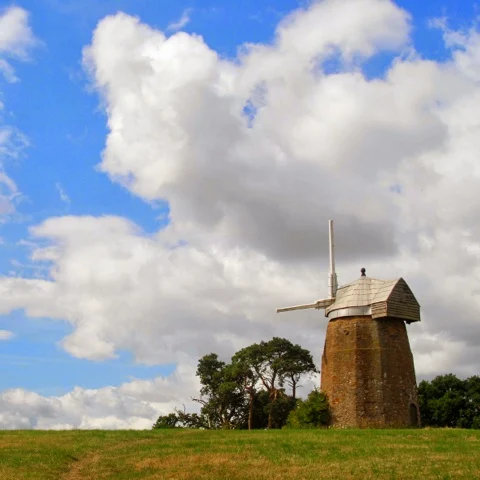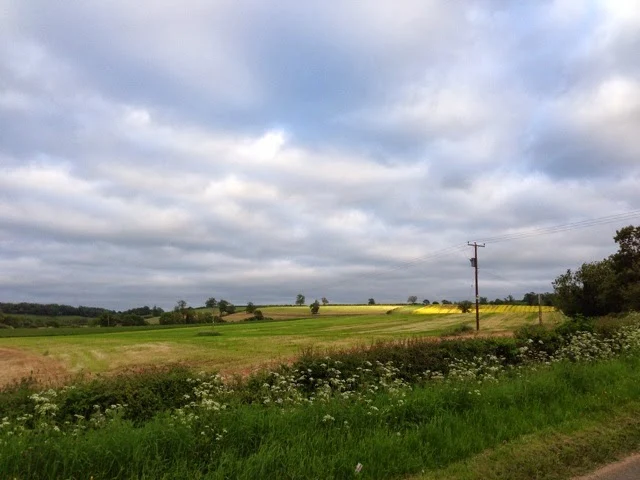In an earlier piece, I mentioned Ian Nairn – rapidly becoming one of my few heroes, the more I read of him and his writings. He once stated that “There is only one real rule, that each place has its own nature, its genius loci.” I recently, too, referred to this ‘spirit of place’; and I now wonder how we could capture that of “the three hamlets of Over, Church and Temple (sometimes known as Upper, Middle and Lower) Tysoe, and their residents” – with a view, perhaps, to using this as a foundation for the villages’ nascent Neighbourhood Plan.
In The American Landscape: a Critical View, Nairn discusses “the art of the environment, the art of placing objects together so that the result is something better than any of the original elements; the art of giving identity to places and hence to the people living in them”. And, in the ‘Sussex’ volume of Pevsner’s The Buildings of England, he describes that county as “a good place both for modern houses and for unspoilt village pubs… fully motorized, fully affluent, yet aware of the need to keep countryside green.” However, in the ‘Surrey’ volume, he protests against “a particularly mean kind of village expansion” that throws out “the old pattern, maybe pickling a few old cottages for appearances’ sake, and not putting anything worth-while in its place.”
I think I prefer the Sussex version as a starting point for any model for Tysoe’s ongoing development; yet appreciate that some of what has already happened to Tysoe has inevitably followed the Surrey model… – albeit a little more sympathetically than in many other places. (Maybe not empathetically, though.) What we don’t want is “a soggy, shoddy, mass of half-digested clichés, half-peeling façades, half-comfortable rooms, untested preconceptions about what people want… ignoring what people are like in all their frailty and diversity”, as he wrote in his seminal Observer article ‘Stop the Architects Now’. The Neighbourhood Plan must reflect the needs – and wants – of where we live; why we live there; how we live there; how our children will live there.
Close your eyes for a moment. Remember your first view of Tysoe – as a small child, born into the village; as a newcomer, like me. What was it that made this place special; memorable; a place where you wanted to base your life – if not all of it, then at least a sizeable chunk of it?
Ignore the house you live in – whether this be a mansion, farm, or semi – and remove the considerations of cost, affordability, and the facilities your particular home provides. Perhaps, for a moment, envisage yourself floating high above the village. (And, if you find this difficult, load up the satellite view of Google Maps, briefly; and then re-close your eyes.) Swoop around – like the boy in The Snowman – visiting the parts of the parish that you love best.
Now, remove all the buildings. What was the vale like before people began to settle here? Before St Mary’s was built in the 11th century? Before the cores of the three separate settlements really took shape in the 17th century? Before the Red Horse was carved – around the same time, perhaps… – and then erased? Why did people settle here throughout that millennium? Why did our three villages grow? How did they grow? How did those people live and work? Why did they stay – or move away? What attracted them? What made it hard for them? What made it hard for them to stay or move away?
Take a deep breath. Then take all that you have seen; and add the buildings in, as you imagine the three Tysoes evolving, developing, growing, in fits and starts – right up to the present day. What was good (in your eyes – no-one else’s matter, at this point…)? What was bad? What lessons can be learned, as we go forward? What successes should be repeated; what mistakes avoided? How would you like the villages to evolve, develop, grow? (And no: you don’t have the option to preserve them in aspic. Between now and 2031, we have been told that Upper and Middle Tysoe must accept between fifty-one and seventy-five new houses.)
Did those (large) numbers wake you from your reveries? I’m not surprised. However, close your eyes again; remember the place your thoughts have already brought you to. If you wish, or need to, write those thoughts down, before proceeding….
Where could we put all those houses? In fields; filling in gaps; replacing – or remodelling – existing buildings? What should they look like – individually; corporately? Who will live in them? What will their collective impact be on us; our successors; our villages; our surroundings; our environment? Can any negative aspects be ameliorated? How? Who by? Before or after they are built? What positive factors do they bring with their emergence? How do they affect your imagined history of the three Tysoes, as it spirals off into the future…?
Go for a walk around your village. (Open your eyes, first, though!) Does this change the thoughts you’d had; the conclusions you’d reached?
Ian Nairn believed that the only way to counteract architects and developers designing and constructing unsuitable buildings, bulldozing over fields and over residents’ desires, was “The public head of steam…”; and that “All it needs is a channel.” Thanks to the 2011 Localism Act, we now have that “channel”: the development of a Neighbourhood Plan giving us all an opportunity to have a say in how the built environment in our parish develops to meet existing and future demands.
Distilling Nairn’s approach (or even teachings) in their recent book Ian Nairn: Words in Place, Gillian Darley and David McKie summarize it thus…
Go and look at this place. See what you think. See how you feel. Respond. And if it is being diminished, if the flavour is being squeezed out of it, think about how you might respond to that, too.
…and I don’t think we could have better instructions in place as to how we, as a village, kick off our own Neighbourhood Plan.
PS: Fare thee well, Tony Benn – conviction politician extraordinaire; and another hero. As Ed Miliband said, he “spoke his mind and spoke up for his values. Whether you agreed with him or disagreed with him, everyone knew where he stood and what he stood for.”





No comments:
Post a Comment